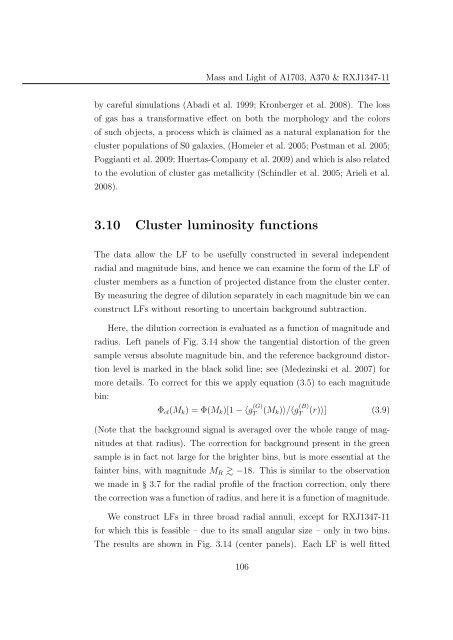Mass and Light distributions in Clusters of Galaxies - Henry A ...
Mass and Light distributions in Clusters of Galaxies - Henry A ...
Mass and Light distributions in Clusters of Galaxies - Henry A ...
Create successful ePaper yourself
Turn your PDF publications into a flip-book with our unique Google optimized e-Paper software.
<strong>Mass</strong> <strong>and</strong> <strong>Light</strong> <strong>of</strong> A1703, A370 & RXJ1347-11<br />
by careful simulations (Abadi et al. 1999; Kronberger et al. 2008). The loss<br />
<strong>of</strong> gas has a transformative effect on both the morphology <strong>and</strong> the colors<br />
<strong>of</strong> such objects, a process which is claimed as a natural explanation for the<br />
cluster populations <strong>of</strong> S0 galaxies, (Homeier et al. 2005; Postman et al. 2005;<br />
Poggianti et al. 2009; Huertas-Company et al. 2009) <strong>and</strong> which is also related<br />
to the evolution <strong>of</strong> cluster gas metallicity (Sch<strong>in</strong>dler et al. 2005; Arieli et al.<br />
2008).<br />
3.10 Cluster lum<strong>in</strong>osity functions<br />
The data allow the LF to be usefully constructed <strong>in</strong> several <strong>in</strong>dependent<br />
radial <strong>and</strong> magnitude b<strong>in</strong>s, <strong>and</strong> hence we can exam<strong>in</strong>e the form <strong>of</strong> the LF <strong>of</strong><br />
cluster members as a function <strong>of</strong> projected distance from the cluster center.<br />
By measur<strong>in</strong>g the degree <strong>of</strong> dilution separately <strong>in</strong> each magnitude b<strong>in</strong> we can<br />
construct LFs without resort<strong>in</strong>g to uncerta<strong>in</strong> background subtraction.<br />
Here, the dilution correction is evaluated as a function <strong>of</strong> magnitude <strong>and</strong><br />
radius. Left panels <strong>of</strong> Fig. 3.14 show the tangential distortion <strong>of</strong> the green<br />
sample versus absolute magnitude b<strong>in</strong>, <strong>and</strong> the reference background distortion<br />
level is marked <strong>in</strong> the black solid l<strong>in</strong>e; see (Medez<strong>in</strong>ski et al. 2007) for<br />
more details. To correct for this we apply equation (3.5) to each magnitude<br />
b<strong>in</strong>:<br />
Φ cl (M k ) = Φ(M k )[1 − 〈g (G)<br />
T<br />
(M k)〉/〈g (B)<br />
T<br />
(r)〉] (3.9)<br />
(Note that the background signal is averaged over the whole range <strong>of</strong> magnitudes<br />
at that radius). The correction for background present <strong>in</strong> the green<br />
sample is <strong>in</strong> fact not large for the brighter b<strong>in</strong>s, but is more essential at the<br />
fa<strong>in</strong>ter b<strong>in</strong>s, with magnitude M R −18. This is similar to the observation<br />
we made <strong>in</strong> § 3.7 for the radial pr<strong>of</strong>ile <strong>of</strong> the fraction correction, only there<br />
the correction was a function <strong>of</strong> radius, <strong>and</strong> here it is a function <strong>of</strong> magnitude.<br />
We construct LFs <strong>in</strong> three broad radial annuli, except for RXJ1347-11<br />
for which this is feasible – due to its small angular size – only <strong>in</strong> two b<strong>in</strong>s.<br />
The results are shown <strong>in</strong> Fig. 3.14 (center panels). Each LF is well fitted<br />
106
















